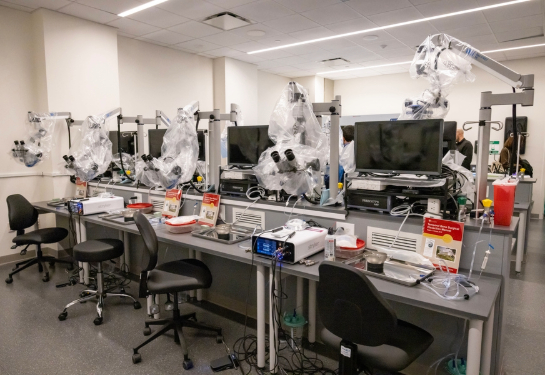Inhaled statins show promise as effective asthma treatment
Statins are a class of drugs commonly used to lower bad cholesterol, but can they also treat obstructive airway diseases, such as asthma?
UC Davis Health pulmonologists taking part in an NIH-funded study are exploring an innovative approach to determine whether statins may help treat obstructive airway diseases by delivering the medication via inhalation.

“Delivering statins by inhalation is a creative way to deploy a drug that has potent biological effects in pre-clinical cell-based and animal model studies,” said Amir A. Zeki, the principal investigator of the study and professor of internal medicine who specializes in pulmonary, critical care and sleep medicine. “Because oral statins do not penetrate the airway compartment at high enough levels to be effective, delivering statins directly to the lung via inhalation might achieve better local tissue drug levels, and therefore, better clinical results. This allows the use of lower drug doses to achieve efficacy while also minimizing systemic side effects.”
Understanding obstructive airway diseases
Asthma is a chronic lung disease affecting people of all ages. Signs and symptoms include shortness of breath, chest tightness or pain, wheezing when exhaling, and coughing or wheezing attacks that are worsened by a respiratory virus.
Asthma is the most common chronic respiratory illness in children affecting one in every 12 children. Asthma is the leading cause for sick visits in clinics as well as emergency room visits and missed school days in children.
According to the Centers for Disease Control and Prevention, 26.5 million Americans have asthma. Of these individuals, 20.4 million are adults and 6.1 million are children.
Chronic obstructive pulmonary disease (COPD) is also an airway disease that leads to symptoms of breathlessness and wheezing. It affects 16 million individuals in the United States. The global prevalence of asthma and COPD exceeds 474 million people.
The airway smooth muscle (ASM) resides within the airway wall. It controls and regulates airflow. A hyperactive ASM is linked to the worsening of asthma and COPD symptoms. Therefore, the ASM is an essential therapeutic target for both diseases.
Asthma is caused by inflammation and ASM tightening, which makes breathing difficult. To relax the ASM, current therapies stimulate specific receptors on the ASM cell surface leading to ASM relaxation, bronchodilation and improvement in symptoms such as breathlessness and wheezing.
“Despite their widespread use, current inhaler therapies that treat asthma and COPD remain inadequate in controlling symptoms for many patients, especially those with moderate to severe disease,” Zeki explained. “For this reason, we need novel inhaled medications to treat obstructive airway diseases such as asthma via mechanisms of action different from current standard-of-care therapies.”
We need novel inhaled medications to treat obstructive airway diseases such as asthma via mechanisms of action that are different than current standard-of-care therapies.” —Amir Zeki
How do statins treat obstructive airway diseases?
Statins are a class of lipid-lowering medications that can decrease cholesterol levels in those at high risk of cardiovascular disease. Beyond their cardiovascular benefits, the statins also have anti-inflammatory effects. In asthma pre-clinical studies, the statins decreased airway epithelial cell dysfunction, ASM cell proliferation, immune cell activation, and the release of various pro-inflammatory mediators.
In animal models, statins also showed efficacy in both acute and chronic allergen-mediated asthma. However, oral statin clinical trials in asthma have had mixed to largely negative results.
To better understand why human clinical trials have not been fruitful, Zeki and his team of researchers are examining the mechanisms and pharmacology by which statins affect ASM function in asthma.
“To our surprise, we have discovered that statins also work as a bronchodilator, in which they directly relax ASM tissue, leading to the opening of airways,” Zeki explained. “Instead of working through the cell surface receptors, the statins target the signaling cascade inside the ASM. This targeting happens partially through the cholesterol pathway and partially through cholesterol-independent pathways related to ASM’s protein structure.”
Benefits of inhaling statins
When a drug is taken orally, it enters the liver where it gets metabolized and its efficacy is reduced, a process known as first pass liver metabolism. Zeki’s research team has recognized the advantage of leveraging inhaling statins by bypassing this first pass liver metabolism. Inhaling the statins would allow them to penetrate the airway compartment, including the ASM layer.
“Inhaling statins for the treatment of pulmonary disorders is a much more effective way to deliver this class of medications because of statins’ pharmacology and unique physiochemical properties,” Zeki said. “This allows us to deliver significantly lower doses to the airways with hopefully greater potency.”
Moving forward, Zeki’s team plans to expand its research with a Phase 1 and Phase 2 human clinical trial to test the safety and efficacy of delivering statins by inhalation to treat asthma and COPD.
“We have successfully developed a proprietary formulation that is available and ready for first-in-human testing,” Zeki added. “Our aim is to begin with asthma, but we also have plans to investigate COPD as well.”
Kiran Nandalike, chief of pediatric pulmonology at UC Davis Health, said that it is exciting to learn about non-steroidal medications for asthma.
“Even though the use of statins is limited to animal models currently, we are excited about this development happening at our own center and are looking forward to hearing its application in human subjects,” Nandalike said.




